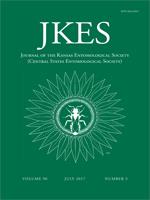Sunflower stem weevil, Cylindrocopturus adspersus LeConte (Coleoptera: Curculionidae), larval feeding on pith and vascular tissues can weaken stalks of cultivated sunflower, leading to breakage and loss of harvestable yield. Previous research has suggested host plant resistance (HPR) to this pest is possible, but results have been difficult to interpret because of limited comparisons to cultivated inbreds and hybrids, along with possible confounding effects of stem diameter. Trials in Kansas (2012) and Nebraska (2015) were used to help reassess the value of germplasm with putative resistance to sunflower stem weevil. Field tests in 2012 included 28 inbreds and hybrids and three entries previously identified as resistant. Though a putative resistance source, PI 386230, was infested with fewer weevil larvae per stem than several hybrids, differences primarily appeared to be due to stem diameter, which is strongly correlated with the number of weevil larvae per stem. A follow-up trial in 2015 suggested differences in larval infestation were not attributable to other qualities in groups of germplasm that differ in stem diameter (i.e., males, females or hybrids), but that changes in plant density predictably alter both stem diameter and numbers of stem weevil larvae. Though resistance to sunflower stem weevil and other stem-feeding pests may be possible, the cost and difficulty of developing HPR, declining severity of the pest, and availability of other simple management options are significant disincentives to additional research.
How to translate text using browser tools
1 July 2017
Reassessment of Resistance to Sunflower Stem Weevil, Cylindrocopturus adspersus LeConte (Coleoptera: Curculionidae), in Cultivated Sunflower Germplasm
Jarrad R. Prasifka,
Jeffrey D. Bradshaw,
Robert M. Aiken
ACCESS THE FULL ARTICLE
breeding
Dectes
diameter
host plant resistance
hybrid
inbred





